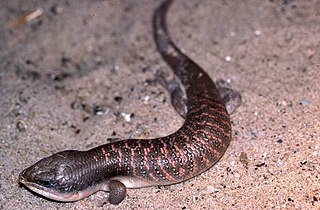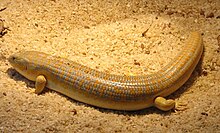
Skinks are lizards belonging to the family Scincidae, a family in the infraorder Scincomorpha. With more than 1,500 described species across 100 different taxonomic genera, the family Scincidae is one of the most diverse families of lizards. Skinks are characterized by their smaller legs in comparison to typical lizards and are found in different habitats except arctic and subarctic regions.

The genus Eumeces comprises four African to Middle-Eastern skink species.

Plestiodon anthracinus, the coal skink, is a species of lizard which is endemic to the United States.
François Marie Daudin was a French zoologist.

The trinket snake, also known commonly as the common trinket snake, is a species of nonvenomous constricting snake in the family Colubridae. The species is native to southern Central Asia.
Eumeces blythianus, commonly known as Blyth's skink, is a species of lizard in the family Scincidae. The species is native to South Asia.

Eurylepis taeniolata, the ribbon-sided skink, alpine Punjab skink, or yellow-bellied mole skink, is a species of skink found in Central Asia, South Asia, and West Asia. It is the type species of the genus Eurylepis.
The white-spotted supple skink is a species of diurnal, terrestrial, insectivorous skink found in parts of tropical Asia. This species was first described by John Edward Gray based on type specimen collected by T. C. Jerdon from Madras, in the Coromandel Coast of South India.

Riopa guentheri, commonly known as Günther's supple skink and Günther's writhing skink, is a species of lizard in the family Scincidae. The species is endemic to India.
Eutropis beddomei, commonly known as Beddome's mabuya or Beddome's skink, is a species of lizard in the family Scincidae. The species is native to India and Sri Lanka.
Ophiomorus tridactylus, commonly known as the three-toed snake skink, is a species of skink endemic to sandy desert areas of South Asia. It is also called the Indian sand-swimmer for its habit of moving just under the sand.

Plestiodon is a genus of lizards in the family Scincidae (skinks). The genus contains many species formerly classified under the genus Eumeces, except those now placed in Mesoscincus. They are secretive, agile animals with a cylindrical body covered with smooth, shiny scales. They are distributed from East Asia to throughout North America from southern Canada south to Mexico, including oceanic islands such as Bermuda.

Ablepharus budaki, commonly known as Budak's skink and Budak's snake-eyed skink, is a species of lizard in the family Scincidae. The species is endemic to the Near East.

Eumeces algeriensis, commonly called the Algerian skink, Algerian orange-tailed skink, Berber's skink, in French eumece d'Algérie, or in Spanish bulán, is a species of skink in the family Scincidae. The species is endemic to the Maghreb region of North Africa.

Acontias gracilicauda, the slendertail lance skink or thin-tailed legless skink, is a species of skink. It is found in the Republic of South Africa and Lesotho. Acontias namaquensis was formerly included in this species as a subspecies, but is now recognized as a distinct species.
Choleoeimeria is a genus of alveolate parasites that infect the biliary tracts of reptiles. Morphologically they are similar to the Eimeria, to whom they are closely related. The genus was described in 1989 by Paperna and Landsberg.

Bosc's fringe-toed lizard or Bosk's [sic] fringe-fingered lizard is a species of lizard in the family Lacertidae. The species is endemic to North Africa and Western Asia. Three subspecies are sometimes recognised; A. boskianus boskianus, from Lower Egypt; A. boskianus euphraticus from Iraq; and A. boskianus asper from the rest of the range; however this division is unsatisfactory because each subspecies has much variation and the differences between them are not consistent.
Nessia layardi, commonly known as Layard's snake skink or Layard's nessia, is a species of skink, a lizard in the family Scincidae. The species is endemic to the island of Sri Lanka.
Nessia sarasinorum, commonly known as Sarasins's snake skink or Müller's nessia, is a species of lizard in the family Scincidae. The species is endemic to the island of Sri Lanka.












